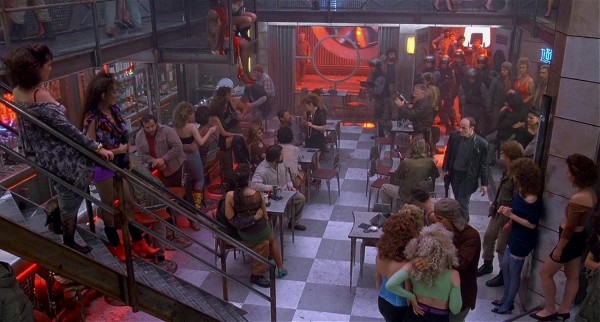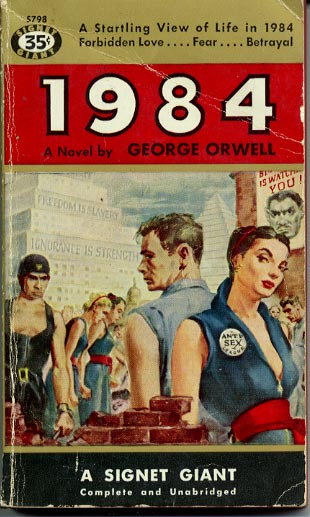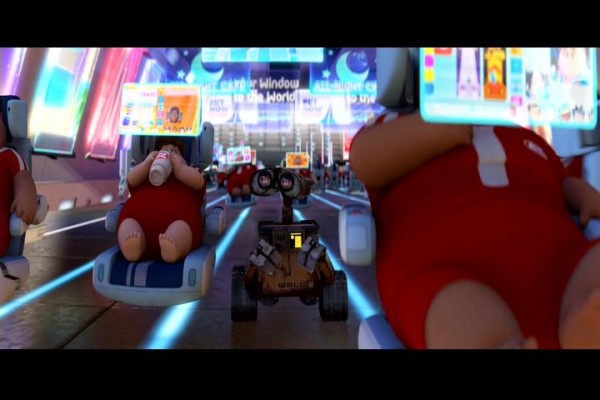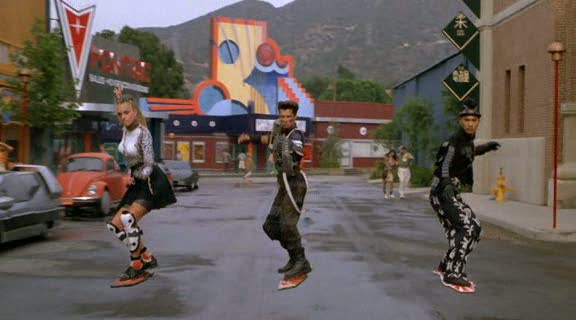In the Year Twenty-Thirteen, Mankind is…..living pretty much the same way as we lived fifty years ago. Only with Facebook.
Isn’t the 21st Century disappointing sometimes? It seems like the generations that came before us had such grand visions of where civilization would be up to by now, and what kind of things we’d be doing (colonizing space, eating all our food in pill food) and no, life isn’t like that at all. But let’s imagine for a moment how it could have been, or what it might still be like…with our Top 10 Futuristic Societies.
10. Brave New World

Let’s start with the society after which all other future societies are named – the “Brave New World” of Aldous Huxley’s novel. It was intended as a parody of H.G.Wells’ positive visions of the future, but it gained a life of its own and its title is now used in journalistic rhetoric for any idea that might be considered radical or future-changing, even when it’s a bit mediocre. The “World” itself is rather terrifying – babies are grown in hatcheries and conditioning centers, rather than being born, and the fetuses deemed to be among the lower castes are deliberately stunted so that they never have any ambition or rebellion in their characters. There is no concept of family or relationships – sex is merely recreational. People are happy, and die happy, knowing that the society carries on without them. But of course, someone breaks the mold and it all goes downhill from there. Still, an interesting model while it lasted.
9. The Matrix

There’s more mass mind-control in the world of the 1999 hit movie. On the surface, all is the same as it as ever was – humans go to work, get paid, go home. But reality is all just a façade, computer generated by “The Machines”. If someone chooses not to take their blue pill, and instead takes a red one, then they will fall out of the Matrix into the real society of the day – one where the humans are all contained within a megacity and plugged into a machine that simulates the world of 1999. Once you understand this, you can manipulate the “matrix” to give yourself superhuman powers, and therein follows a series of battles with sentient computer programs called “Agents” while flying through the air, dodging bullets and looking cool. If someone never takes the red pill, they spend their entire life in a pod, wired up to the program and their entire virtual life doing a dull office job. Best to take the red pill….
8. Battlestar Galactica

A recurring element of futuristic stories is man’s journeys into space. And Battlestar Galatica is no exception, starting with the premise that humans are mainly living on distant planets known as “The Colonies”. When these colonies are destroyed by the Cylons, machines gone rogue, the only survivors are the people who are aboard spaceships at the time. The TV series then follows the fortunes of the only military ship left – the Battlestar Galactica – as it tries to protect the civilian ships from further attack.
As societies go, it’s not dissimilar to our own, but it’s in space. There are political feuds, personality clashes and ridiculous displays of bravado. They eat what we eat, they dress like us when not in uniform and their language is delibrately un-technological. But the fact they have the technology to conquer distant star systems suggests it’s a society that’s far more advanced than ours. Their religion is also very different, with humans worshipping multiple gods, in the Greek tradition, and drinking ambrosia. An interesting mix of past, present and future.
7. Logan’s Run

There’s a common theme to a lot of these futuristic societies – everything is happy as long as no-one questions or tries to fight against the system. Such is the world of “Logan’s Run” – where the citizens of the 23rd century live happy and fulfilled lives under a giant dome. There is no population problem, but there is a small ritual that citizens must go through at the age of 30. It involves being vaporized, on the promise of being “renewed”. To this end, all citizens wear a crystal in their hand, which glows red when the end is near.
Of course, Logan is the one to rock the boat, and run away when his crystal starts prematurely glowing, rather than accept his fate with the expected dignity. And this inevitably leads to the downfall of the whole utopic society. There are two different versions of events, depending on whether you’re watching the film or reading the original novel, but the take-home message stays the same – if your society seems too good to be true, just accept it. Ask no questions.
6. Judge Dredd

A lot of these societies seem blissful, at least on the surface. Not so much Mega-City One, from the British comic 2000AD. It’s ruled over by ruthless Judges, who have few moral gray areas and rarely hesitate before chucking citizens into “The Cube”. The city covers most of the East Coast of America, with much of the Judge Dredd action taking place in a futuristic version if New York, circa 2099. The population is somewhere between 100million and 800million (the figure has varied over the long-running series) and they live in huge apartment blocks of 50,000 although some have to travel the city constantly on transport pods called mo-pads, thanks to a housing shortage.
Outside the city is a nuclear wasteland, and much of the city itself is destroyed in a Soviet attack in 2104. Laws are harsh – it is illegal to consume both sugar and coffee or smoke outside the Smokatoriums. Doesn’t sound like fun, does it? Well, at least citizens can entertain themselves at the alien zoo…
5. Total Recall

Another dystopian work that fits the mantra of “don’t ask, you don’t want to know”. Loosely based on a Philip K.Dick novel, this 1990 movie starred Arnold Schwarzenegger, some ropey special effects and a lot of 80s-style incidental music. It’s set on the Earth of 2084, when Mars has been colonized and Arnie keeps dreaming about going there. In this society, you take a vacation by going to a processing plant and having virtual reality vacation memories stuck into your head, so Arnie plumps for a virtual trip to Mars and then realizes his dreams are his actual memories. If you’ve been paying attention so far, you’ll know that questioning the norm never ends well…
As for the society itself, some things are different (the red light district is populated by mutants and people can do freaky things with their faces) but largely it looks like everyone’s just dropped in from the 80s. Maybe it was actually meant to be set, not in 2084 but 1984…
4. 1984

Which could not lead more neatly onto our next dystopia. Big Brother is watching, your thoughts are dictated by the state and the world has been divided into three superpowers, who fight each other all the time and change sides entirely arbitrarily. In George Orwell’s masterpiece, a classic novel of the “futuristic” genre, it is again the act of one man questioning the state that leads to his downfall and imprisonment in the dreaded Room 101. However, by the end of the novel he has once again become a state drone so it works out better for him than for some of our other protagonists. A chilling vision of a future society, but it did entirely fail to predict what actually happened in 1984 – not one mention of Van Halen’s “Jump” and the duet between Paul McCartney and Michael Jackson seemed to be totally off Orwell’s radar. Some shocking omissions.
3. Wall-E

And now for something slightly different – the future as imagined by Pixar. In this heart-wrenching animation, Earth has been rendered unusable, thanks to the actions of mankind. Garbage is piled in huge heaps everywhere, surrounded by abandoned outlets of the “Buy N Large” corporation. A soulful robot named Wall-E trundles around, shifting the rubbish into cubes and dreaming of having some company. Meanwhile, the human race are circling above the Earth in a giant luxury space cruiser, where every day is perfect. They have evolved so that they’re too fat to move under their own power and just go everywhere on floating chairs but eventually have to learn to walk again. If you look ever so hard, you might spot a subliminal message or two in there…!
2. A Clockwork Orange
But bleak as Pixar’s vision of the future is, it’s nothing compared to Anthony Burgess‘ descriptions in his novel “A Clockwork Orange”. In it, society is overrun by ultraviolent youths such as Alex and his “droogs”. Wearing bowler hats and codpieces, they beat up the old and the vulnerable for fun, all the time talking in their cod-Russian dialect. The drink of choice is “Moloko” -a type of milk with “knives in it”, preferably drunk off tables shaped like women. The book was made into a film by Stanley Kubrick, but he took it upon himself to ban it in case it incited the kind of violence contained within. A dark vision indeed.
1. Back to the Future

So, after so much violence, cloning, dictatorship and murder, it’s refreshing to end on a positive, and not very serious, vision of the future. The future that Marty McFly visits in the iconic 80s movie “Back to the Future II” is all wacky technological advances – pizzas that come in dehydrated form and “rehydrate” in seconds, zero-gravity boots and, of course, hoverboards. As a kid growing up around the time the films were released, you felt pretty confident that, come 2015, this was how life would be. Sadly, that is just two years away and I’m yet to see a single hoverboard – apparently, I’m not alone in feeling cheated!